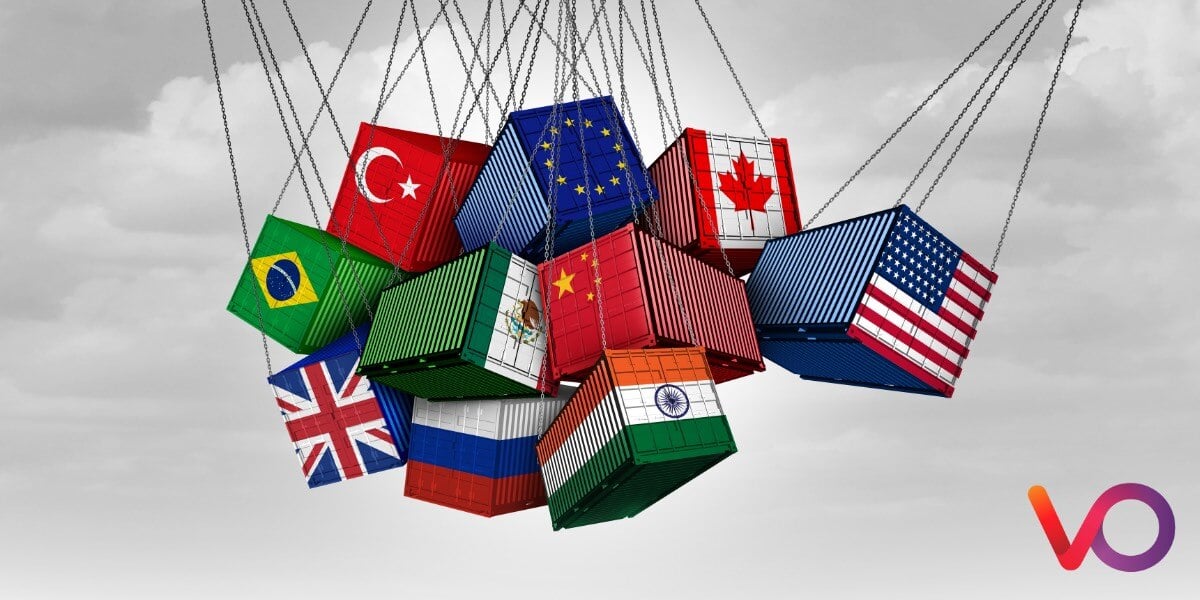Industry insights: How global trade tensions and tariffs could impact streaming services, why algorithms are now more important than word-of-mouth for recommendations, and content production becomes increasingly global.
Even streaming services might be hurt by Trump’s tariffs
[Wired]

While it may be tempting to think that streaming has been immune to the disruption in the global economy following the introduction of the US administration’s tariff policies, the reality is not quite as simple. The ongoing trade tensions are already causing real-time disruptions for manufacturers. One broadcast camera manufacturer at NAB launched a new camera at one price on Friday, added 32% to it on Monday, then scaled that back to only a 10% increase on Tuesday as it worked out how to switch production lines from one country to another. A few days later, none of that effort mattered.
As of the time of writing, all goods arriving in the US are subject to a 10% tariff, unless they originate in China in which case it is 145%. China, meanwhile, has imposed a reciprocal 125% tariff on US goods.
Depending on when you read this, those numbers might already be different. And while tariffs have so far only been applied to physical goods, these shifts have an effect on global economy across virtually all sectors – and streaming is no exception.
Possible repercussions of a potential economic downturn and reduced disposable income include consumers deciding to subscribe to fewer streaming services. We are already seeing a reluctance from consumers to carry the same number of services as was evident at their peak during the pandemic in many markets, and this behaviour will only be exaggerated. The core services, which in most markets means Netflix, will likely remain most unaffected, but the ones that consumers tend to churn on for specific content could see increased volatility.
There is also a potential downturn in advertising revenue to consider. This can be industry specific (foreign auto makers still face a 25% tariff on US imports) or part of a wider picture of a possible recession. Streaming’s diversification into FAST and ad-supported tiers has been good for the growth of the business, but does leave it open to potential risk in this area.
“With streaming platform operators increasingly turning to ad-supported tiers to bolster profitability—rather than just rolling out price increases—this strategy could be put at risk,” Matthew Bailey, who analyzes advertising for Omdia told Wired. “Against this backdrop, I wouldn’t be surprised if we do see some price increases for some streaming services over the coming months.”
There are a few industry-specific consequences to consider too.
- First, some of the main streaming services are owned by Big Tech companies who may well be hardest hit by the imposition of tariffs. Apple and Amazon are particularly exposed here if the situation continues or escalates.
- There is also the potential for content production to have to move to different countries if equipment starts to become difficult to obtain and production costs rise, though this might just be accelerating a trend already fairly locked in by the industry (see third story below).
- And lastly, there are rumours of cultural boycotts. China is planning to further limit the number of US films that can be released in the country, which will have consequences given it is the world’s second-largest film market and accounts for 10-20% of average Hollywood blockbuster takings. Consumer-led protests against American goods meanwhile are also spreading across Europe. It is, at best, a volatile situation.
Key takeaway: As Wired concludes: “Streaming, one of the more affordable entertainment options around, has the potential to stay in consumers’ budgets longer than, say, new cars or iPhones. But that doesn’t mean it’ll stay there forever.”
Research: Algorithms beat word-of-mouth for content choices
Word of mouth always used to be seen as the gold standard for content recommendations by consumers. But as recommendation engines become steadily more sophisticated, that seems to be changing.
According to new research, among global Internet users, 26% now rely on streamers’ algorithm picks to decide what TV and film to watch, versus 23% who rely on word-of-mouth recommendations.
Both these lag behind preferred genre and preferred actor/actress, but finish ahead of good reviews and social media buzz.
Here’s the full table.

While it is tempting to think that the amount of money that is typically spent on social and on boosting reviews could perhaps be better diverted to improving recommendations, there are some interesting variations in the data when you zoom in from a global perspective.
- 30% of viewers aged 25 to 34, and 31% of subscribers in households with young children, now rely on the platforms’’ personalized recommendations
- For Gen Z audiences, social media is the key influence. 31% of 18 to 24-year-olds surveyed watch long-form content they’ve learned about on social media.
- 27% of US users rely on algorithm recommendations, compared to 24% of users in Western Europe.
- Narrowing it down even further reveals a preference for algorithms at two extremes of 30% (UK, India, China), and only 19% (France and Italy)
Key takeaway: While there is no one-size-fits-all policy, the global trend is interesting. Broadcasters that are not investing in sophisticated content recommendation services could be failing to maximize the monetisation potential of their libraries.
Global streamers’ shift to investing in non-US scripted content looks permanent
In the first half of 2023, 45.9% of scripted content produced by the top global streaming companies originated in North America. According to data from Ampere Analysis, that figure slumped to 37% by the time we got to the second half of 2024.
This is a significant shift in the production landscape that started post-pandemic due to high production costs and slowing US subscriber growth and then accelerated in the wake of the 2023 writers’ and actors’ strikes. Ampere contends that there is a lasting shift in commissioning strategies, that is now baked into the production landscape as media companies look to produce more localized content for expanding regional markets.
Western Europe has been a key beneficiary here, expanding its share of global streamers’ commissions from 22.5% in early 2022 to a peak of 31.9% in early 2024, before dropping to 27.9% in late 2024. “This suggests the region’s share may have hit a plateau as local streaming markets reach maturity,” reckons Ampere.
It does however remain a key hub for high-value genres such as Crime & Thriller, accounting for a record 43% of the streamers’ global TV commissions in the genre in 2024.
APAC grew from 17.4% in early 2022 to a peak of 26.2% in early 2024. It remains a key growth market, and global streamers are prioritizing local originals to attract subscribers. An increasing number of high-budget productions in areas such as Sci-Fi & Fantasy are also originating from the region and these are proving popular in other markets as well.
Elsewhere, regions such as Central and South America, Central and Eastern Europe, and Sub-Saharan Africa have maintained stable but modest shares of global streamers’ overall commissions. There are opportunities in these places, but the subscriber numbers aren’t yet present to drive investment.
For the near future at least, North America and Western Europe look set to share most of the streamers’ scripted production budgets, but APAC is definitely on the rise as streamers look to grow the subscribed base.
Key takeaways: Content is becoming steadily more diverse - and one of the keys to growth anywhere in the world is providing local content.

